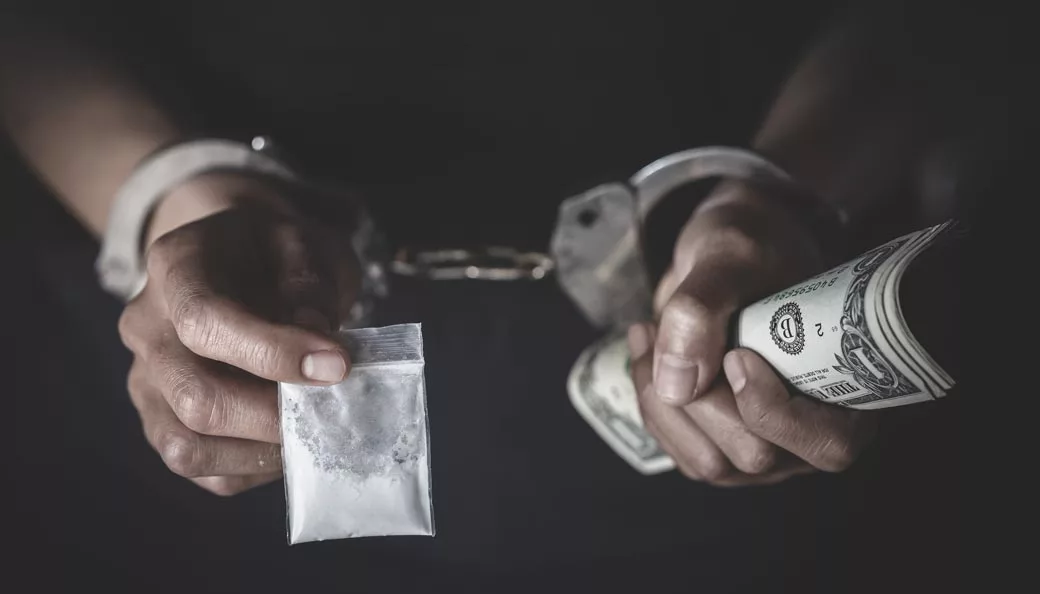
Crack cocaine vs. cocaine: Two narcotics created from the same base substance, with two entirely different final products. It’s not just the visual makeup of these two products that make them different – a variety of contrasting characteristics creates a considerable gap between crack cocaine and cocaine.
What Is Crack Cocaine?
Crack cocaine is a cooked, more pure, and intense version of powder cocaine. This version comes in a hard, rock-like state with a white or sometimes yellow tint.
Instead of coming in a powder form, crack’s more solid-state allows users to smoke this version instead of snorting. Users may also break crack down to a liquid state using lemon juice or another acidic substance and prepare it for injection.
This version of cocaine is highly addictive, with many users becoming dependent on the drug in as little as two weeks. The high of crack is short-lived but incredibly fast-acting and intense. This is because of the reaction that takes place during the cooking process, which leads to the elimination of hydrochloride, leaving only pure, smokable cocaine.
The Cooking Process
There are several reasons distributors cook cocaine with the intention of producing crack as the finished product, but the driving force behind the process is usually the same – higher profits. Cooking cocaine into crack allows dealers to take their supply of cocaine and nearly double it with the addition of certain materials. What does the cooking process consist of?
When cocaine is turned into crack, the original form is placed into a jar or glass of water, which is dropped into a larger pot of boiling water. Baking soda or ammonia is added to this mixture, allowing all of the ingredients to heat together slowly.
The cook slowly stirs the mixture, being careful not to separate the ingredients. After a certain amount of time, the jar is removed from the boiling water and placed into a waiting pot of cold or iced water.
The Profitability of Cooked Cocaine for Dealers
The subsequent reaction includes the crack rising to the top as it hardens. After removing the product from the water, it’s placed on napkins or towels where it can dry and continue to harden. The finished product is a form of pure cocaine, separated from the hydrochloride that’s added during the process of manufacturing cocaine paste.
Afterward, dealers typically cut the product down into small pieces, preparing $5, $10, or $20 offerings. This is what makes crack cocaine so profitable, as it’s a stark contrast to the average price of cocaine, which is normally around $100 per gram. Dealers rarely stray from packaging powder cocaine into any smaller offerings than full grams.
What about cocaine hydrochloride? How is this substance made up and created when compared to crack?
What Is Cocaine Hydrochloride?
Cocaine hydrochloride is the street version of cocaine, which is typically a white or off-white powdered or crystalline substance. In its purest form, cocaine hydrochloride is actually in a harder, rock form, consisting of shiny, flaky layers that make up uncut “bricks” or kilograms.
This product is created from an alkaloid that originates in the leaves of Erythoxylum coca, or the coca plant, which is native to South America. The leaves of this plant have actually been used for thousands of years, typically being chewed or brewed into a tea to give users high levels of energy.
Originally released in liquid form, cocaine eventually was released in its powdered form and was widely abused because of its euphoric properties. Eventually, the drug was made illegal but is still used for medicinal purposes in rare cases.
How is cocaine hydrochloride created, and what ingredients are used during the process?
How Is Cocaine Hydrochloride Created?
Deep in the jungles of South America, workers harvest the leaves of the coca plant and place them into giant barrels. The leaves are crushed, mixed with an alkaline material such as baking soda, gasoline, and water, and stirred vigorously.
The water and leaves are discarded, and sulfuric acid is mixed with the remaining solution to remove the leftover solvents from the reaction. Baking soda is added once again, and the mixture is dried, creating what’s known as cocaine paste, and is eventually turned into cocaine powder.
The powder cocaine is subsequently packaged into kilogram offerings. Manufacturers or cooks often place a stamp in the middle of these packages to mark their brand.
Understanding how each product is created, it’s much easier to grasp the differences between crack cocaine and cocaine.
The Differences Between Crack Cocaine and Cocaine
There are several differences between crack cocaine and cocaine. Most notably, these two substances have a marked difference in the way they look.
Do Crack and Cocaine Look Different?
Cocaine normally comes in a bright white, powder, or crystalline form. When the substance is in its original kilogram state, it’s a hard, rocky substance that has shiny, flaky layers.
Crack is normally yellowish or off-white and comes in a hard, waxy chunk in different sizes and shapes. These pieces, known as rocks, will often have small holes throughout their form from the release of air after the cooking process.
The list below highlights some additional contrasts between these two substances.
- Crack comes in a smokable form and is injectable when mixed with acidic substances like lemon juice. Cocaine is typically insufflated but is also injectable when mixed with water.
- When used in the traditional ways, crack has a more intense, fast-acting high. The cocaine high takes slightly longer to reach peak effect and isn’t nearly as intense but lasts quite a bit longer.
- Cocaine is typically marketed toward the white-collar, corporate class, while crack cocaine has been more prevalent in impoverished neighborhoods and the inner city. However, research has shown that cocaine can lead to crack addiction.
- Typically cocaine is available at the wholesale level in kilograms, which is subsequently turned into crack. Crack is rarely available at the kilogram level, which is where the price difference comes into play.
How Much do Crack and Cocaine Cost?
At the wholesale level, cocaine prices tend to fluctuate based on the demand, availability, and issues with smuggling routes used by the Mexican drug cartels that flood American streets with this drug.
The location also has a heavy influence on the wholesale prices of cocaine. For example, in California, a kilogram can be purchased for as little as $15,000. However, in locations such as Alaska, a wholesale kilogram can be as high as $45,000.
A wholesale ounce of cocaine is available anywhere from $700 to $1,400 an ounce. When these ounces are kept in the same form, powder cocaine dealers can bring in anywhere from $2,000 to $2,800. Grams typically sell between $70 and $100.
However, when dealers turn the cocaine into crack, ounces can bring in up to $5,000 when broken down for street-level sales. Normally dealers can double one ounce and turn them into two. These ounces are then broken down, where every gram is cut into ten smaller $10 packages.
This is what makes the transformation so attractive to cocaine dealers. However, the monetary cost of cocaine doesn’t present the greatest expense to users and society.
The Total Costs of Cocaine to Users and Society
The cost of cocaine and crack to users measured in dollar amounts can often total into the millions. Users can easily blow through their entire life savings and more when dealing with cocaine abuse disorder.
However, the collateral damage often has a much higher price. Cocaine and crack will cost users their family, friends, jobs, possessions, freedom, and eventually, their lives. The final destination on the long road of crack or cocaine abuse is typically death or prison.
The effects on society are quite substantial as well. In a study conducted back in 1998, it was estimated that the cost of substance abuse on society was $97 billion. It’s unknown where these costs currently lie, but one can only assume because of the marked increase in substance abuse issues, it has inflated dramatically.
These costs include taxpayer money to fund addiction programs, resources for overdose, and funding for jail and prison programs. The direct costs include violence that results because of drug addiction, as well as diseases such as HIV and hepatitis that spread because of IV drug use.
What’s the difference in the negative effects of crack cocaine vs. cocaine?
Effects of Crack Cocaine vs. Cocaine
Let’s examine the overall effects of crack and cocaine in every area—most of the effects are identical in many areas, except for effects on communities. Crack tends to have a significantly higher impact in this area than cocaine.
Effects of Cocaine
- Physical Effects of Cocaine: Increased heart rate, high blood pressure, potential heart conditions, increased energy, or stroke
- Mental Effects of Cocaine: Temporary feelings of euphoria, paranoia, increased alertness, depression, anxiety, and drug-induced psychosis.
- Personal Effects of Cocaine: Loss of family, friends, financial stability, employment, freedom, and life
- Society and Economical Effects of Cocaine: High rates of imprisonment, increased need for rehabilitation programs, higher crime rates, and increased chance for the spread of certain diseases.
In addition, the effects crack has on society, the economy, and communities are substantially higher. The influence on younger generations can be more significant because of the potential for a more severe and intense addiction period and the communities that crack affects.
There is also the chance of a much higher rate of Child Protective Service involvement, leading to severed families and broken homes. This is because of the direct effect of substance abuse issues and imprisonment of users and dealers in these communities.
Because of the severity of these effects, crack cocaine and cocaine laws have significant differences.
Why are Crack Cocaine and Cocaine Laws Different?
The severe impact that crack cocaine had on inner-city families and communities in the early 80s led to the Anti-Drug Abuse Act of 1986. This is also known as the 100 to 1 sentencing act.
The law states that federal drug penalties for crack cocaine would carry sentences 100 times more severe than those for cocaine. In other words, the same penalties for individuals convicted of distribution or possession of crack cocaine would be equal to 100 times more than for the same amount of cocaine.
Regardless of the laws, the issues with cocaine and crack abuse disorder can be equally challenging in their own right. However, withdrawals for crack cocaine vs. cocaine can have a marked difference in intensity.
Withdrawals for Crack Cocaine vs. Cocaine
The withdrawals for crack cocaine vs. cocaine can both be quite severe. However, the withdrawal from crack cocaine can become more intense at times because of the severity of the addictive properties of this form of the drug.
Withdrawals for Cocaine
Withdrawals from cocaine include paranoia, anxiety, depression, sweating, night terrors, and intense cravings.
Withdrawals for Crack
Crack withdrawals include anxiety, intense cravings, stomach cramps, body aches, chills, fever, paranoia, and depression.
Both of these drugs may require rehab or some form of treatment for abuse challenges.
Do People Go to Rehab for Crack?
Many individuals suffering from crack abuse disorder attend rehab or another form of treatment. Options include inpatient or outpatient rehab, consisting of different forms of group therapy and mental health counseling.
Treatment Programs for Cocaine and Crack
There are multiple options for the treatment of cocaine and crack abuse disorders. Inpatient and outpatient treatment services may offer different forms of treatment, including dual-diagnosis, matrix models, and other behavioral therapies.
At Circle of Hope Treatment Center, clients have access to several forms of mental health treatment options, including inpatient and outpatient rehab. Personal recovery plans are constructed with the help of mental health professionals and aftercare services for continued abstinence.
The eventual goal of long-term recovery is possible with the right team on your side. Contact Circle of Hope today to find out how we can help with your substance abuse challenges.

